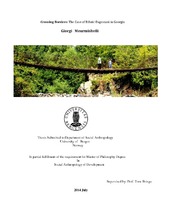| dc.description.abstract | The Anthropology of borders mainly developed from 1990's. As scholars have sought to grasp the changed configuration of borders brought about by the fall of the iron curtain, the enlargement of the European Union (EU), the (re)emergence of ethni-nationalisms, the securitization of migration, and the proliferation of new technologies and techniques for policing trans-border movements" (Reeves 2014:6-7). According to Donnan (2001) it focuses on three main dimensions of border: cultural, social and territorial. In this thesis I will touch all three dimensions of borders. There are different cultural diversities which makes borders and social separation between ethnic Avars and ethnic Georgians. For example, different religions (on the one hand Muslim society, on the other hand Christian society (see chapter three), language (Avar and Georgian), and history; Fredrik Barth argues that this history has produced a world of separate people, each with their culture and each organized in a society which can legitimately be isolated for description as an island to itself" (Barth 1969:11). In my view, based on my ethnographic data material, cultural diversities such as history and language not only separate ethnic groups and create boundaries, but also make boundaries crossable. During my fieldwork I heard many life histories which underline good historical relationship between ethnic Avars and ethnic Georgians (see chapter four). The kinship tradition in the Caucasus called Konagoba, which I will discuss in chapter four, is an example of such a historical relationship between ethnic Avar and ethnic Georgian; the Konag (friend who is hosting particular person and vice versa ) institute is sacred for Caucasians. In first chapter, at first I will give an ethnographic overview of Dagestan. Then I will show the history of Avar villages in Georgia before the Soviet Union, during Soviet Union, in 1990's and in contemporary Georgia. Then I will focus on the period of Soviet Union, and how Stalin's policies of forced population transfers affected Avars in Georgia. In 1944 Stalin forced Avars to settle from Georgia in Chechnya; in 1956 Avars returned from Chechnya to Georgia. Finally, in first chapter I will discuss the methodology I was using during my six-month fieldwork among Avars in Georgia, and how I was first entering the field. My field site is near an international territorial border marked by high mountains, which separates Georgia from Dagestan in the Russian Federation. In chapter two, I will show the changing border politics in three different time periods: 1) during the Soviet Union; 2) during the 1990's; and 3) in contemporary independent nation-state of Georgia. In chapter three I will focus on socio- cultural changes as a consequence of the opening the border between Georgia and Russia in 2010. Describing Avars' everyday activities and rituals, such as cutting down vineyards, building a new mosque, changing wedding ceremonies. I will discuss a villagers' new concern with being a good Muslim". Also, I will compare my ethnographic data material, which was collected in 2008, 2009 (when the border between Georgia and Russia was closed) in the village Tsodna, with my ethnographic data material which was collected in 2013. This comparison gives me reason to suggest that the concern with being a good Muslim" is connected with an increasing number of religious people (mostly young generation) in the village; which itself is connected with the opening of the state border between Georgia and Russia. In last section of chapter three I will focus on the conflict between villagers of Tsodna and Vake. In chapter four I will discuss about economic and kin-relationship between ethnic Avars and ethnic Georgian, which shows opposite picture' then the chapter before. | en_US |
| dc.description.abstract | According to William Zartman Borders run across land but through people. On maps they appear as fine one-dimensional lines, whereas on the ground they have many dimensions. Borders are boundaries in depth, space around a line, place where state meets society" (Zartman 2010:16). It is impossible to understand borders, without peripheral relations between the states and societies they contain. Itself borders are zones in which people create special relationship with other people. In this thesis, I plan to write about the case of a small minority group located on the periphery in Georgia in order to understand how minorities find a place in an ethnically diverse and rapidly changing society. Their responses to changing central policies and border conditions provide an ideal opportunity to see how elements of the population not only respond to, but also actively constitute, the conditions of a border regime and sovereignty. Georgia is a state with a highly diverse population, and boundary conditions are everywhere in the society. In addition, the country has complex borders with neighboring countries such as Russia, where population groups are distributed across boundaries and have a long history of coping with border conditions. Borderlands are zones of varying widths, in which people have recognizable configurations of relationships to people inside the zone, on both sides of the borderline but within the cultural landscape of the borderlands, and, as people of the border, special relationships with other people and institutions in their respective nation and state'' (Donnan and Wilson 1994:8). The post-independence period has been one of rapid change, which makes it possible to observe the ways that sovereignty is formed in local contexts, and the role of elements of the population in relations between the state and the population. In case of the form of comparative analysis of the state border political changes, in this thesis I will show socio-cultural and economic changes of ethnic minority in Georgia. I will show how borders affect the groups living near them. | en_US |
